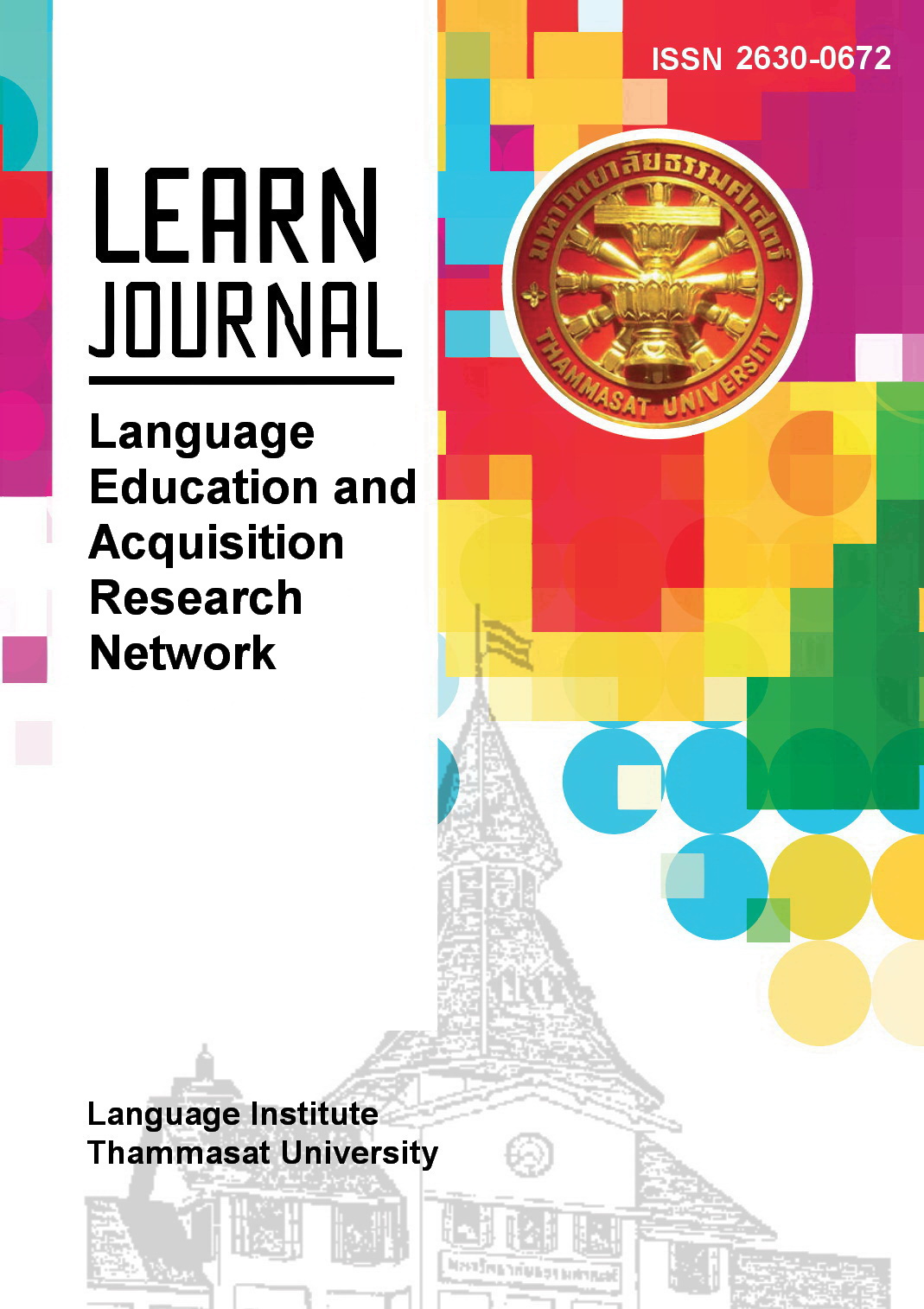Vietnamese Students’ Use of Smartphone Apps in English Learning
Main Article Content
Abstract
Despite an improving interest in mobile-assisted language learning in recent years, little is known about second language (L2) learners’ use of and attitudes to smartphone apps in learning English. This study explores L2 learners’ purposes for and attitudes toward using Smartphone English Language Learning Apps (SELLA) in the Vietnamese context. A sample of 123 Vietnamese EFL students from different universities in Southern Vietnam was invited to fill out a 5-point Likert-scale questionnaire. Data were projected into SPSS 25 for analysis. Results indicated that the participants generally used SELLA to practice and improve all language systems and skills. Also, the students generally showed their positive attitudes toward SELLA. The findings suggest implications for using smartphone apps in English language learning in Vietnam.
Article Details
References
Abdullah, N. A. C., Tajuddin, A. J. A., & Soon, G. Y. (2019). Mandarin students’ perceptions of smartphone applications in Mandarin learning. Universal Journal of Educational Research, 7(A9), 61-70. https://doi.org/10.13189/ujer.2019.071608
Abugohar, M. A., Yunus, K., & Rashid, R. A. (2019). Smartphone applications as a teaching technique for enhancing tertiary learners’ speaking skills: Perceptions and practices. International Journal of Emerging Technologies in Learning, 14(9), 74-92. https://doi.org/10.3991/ijet.v14i09.10375
Aghajani, M., & Adloo, M. (2018). The effect of online cooperative learning on students’ writing skills and attitudes through telegram application. International Journal of Instruction, 11(3), 433-448. https://doi.org/10.12973/iji.2018.11330a
Awada, G. (2016). Effect of WhatsApp on critique writing proficiency and perceptions toward learning. Cogent Education, 3(1), 1264173. https://doi.org/10.1080/2331186X.2016.1264173
Bui, H. P., Hoang, V. Q., & Nguyen, N. H. (2022). Encouraging Vietnamese students’ willingness to communicate: Insights from L2 English classrooms. Language Related Research. [In Press]
Chen, Z. Z., Chen, W. C., Jia, J. Y., & An, H. L. (2020). The effects of using mobile devices on language learning: A meta-analysis. Educational Technology Research and Development, 68(4), 1769–1789. https://doi.org/10.1007/s11423-020-09801-5
Cheung, S. K. S. (2015). A case study on the students’ attitude and acceptance of mobile learning. Communications in Computer and Information Science, 494, 45-54.
https://doi.org/10.1007/978-3-662-46158-7_5
Dashtestani, R. (2016). Moving bravely towards mobile learning: Iranian students’ use of mobile devices for learning English as a foreign language. Computer Assisted Language Learning, 29(4), 815-832. https://doi.org/10.1080/09588221.2015.1069360
Dumpit, D.Z., Fernandez, C.J. (2017). Analysis of the use of social media in Higher Education Institutions (HEIs) using the Technology Acceptance Model. International Journal of Educational Technology in Higher Education, 14(5), 1-16.
https://doi.org/10.1186/s41239-017-0045-2
Gangaiamaran, R., & Pasupathi, M. (2017). Review on use of mobile apps for language learning. International Journal of Applied Engineering Research, 12(21), 11242–11251.
Granić, A., & Marangunić, N. (2019). Technology acceptance model in educational context: A systematic literature review. British Journal of Educational Technology, 50(5), 2572-2593. https://doi.org/10.1111/bjet.12864
Heil, C. R., Wu, J. S., Lee, J. J., & Schmidt, T. (2016). A review of mobile language learning applications: Trends, challenges, and opportunities. The EuroCALL Review, 24(2), 32. https://doi.org/10.4995/eurocall.2016.6402
Hung, B. P. & Nguyen, L. T. (2022). Scaffolding language learning in the online classroom. In R. Sharma & D. Sharma (Eds.), New trends and applications in Internet of Things (IoT) and big data analytics (pp. 45-60). Springer.
Hung, B. P., Anh, D. P. T., & Purohit, P. (2022). Computer-mediated communication and second language education. In R. Sharma & D. Sharma (Eds.), New trends and applications in Internet of Things (IoT) and big data analytics (pp. 109-122). Springer.
Huong, L. P. H. & Hung, B. P. (2021). Mediation of digital tools of English learning. Learn Journal: Language Education and Acquisition Research Network, 14(2), 512-528.
Kacetl, J., & Klímová, B. (2019). Use of smartphone applications in English language learning—A challenge for foreign language education. Education Sciences, 9(3), 1-9. https://doi.org/10.3390/educsci9030179
Klimova, B. (2017). Mobile phones and/or smartphones and their apps for teaching English as a foreign language. Education and Information Technologies, 23(3), 1091-1099.
https://doi.org/10.1007/s10639-017-9655-5
Machmud, K., & Abdulah, R. (2017). Using smartphone-integrated model of teaching to overcome students’ speaking anxiety in learning English as a foreign language. Journal of Arts and Humanities, 6(9), 01. https://doi.org/10.18533/journal.v6i9.1249
Metruk, R. (2021). The use of smartphone English language learning apps in the process of learning English: Slovak EFL students’ perspectives. Sustainability, 13(15), 8205.
https://doi.org/10.3390/su13158205
Miangah, T. M. (2012). Mobile-assisted language learning. International Journal of Distributed and Parallel Systems, 3(1), 309–319. https://doi.org/10.5121/ijdps.2012.3126
Mindog, E. (2016). Apps and EFL: A case study on the use of smartphone apps to learn English by four Japanese university students. JALT CALL Journal, 12(1), 3–22. https://doi.org/10.29140/jaltcall.v12n1.199
Muhammed, A. A. (2014). The impact of mobiles on language learning on the part of English foreign language (EFL) university students. Procedia - Social and Behavioral Sciences, 136, 104–108. https://doi.org/10.1016/j.sbspro.2014.05.297
Naderi, S., & Akrami, A. (2018). EFL learners’ reading comprehension development through MALL: Telegram groups in focus. International Journal of Instruction, 11(2), 339-350. https://doi.org/10.12973/iji.2018.11223a
Nguyen, Q. N. & Hung, B. P. (2021). The Dogme approach: A radical perspective in second language teaching in the post-methods era. Journal of Language and Education, 6(3), 173-184. https://doi.org/10.17323/jle.2020.10563
Şad, S. N., Özer, N., Yakar, Ü., & Öztürk, F. (2020). Mobile or hostile? Using smartphones in learning English as a foreign language. Computer Assisted Language Learning, 1-27. https://doi.org/10.1080/09588221.2020.1770292
Sarigöz, O. (2016). A study on the views of secondary school students toward professional practice. Online Journal of Social Sciences, 53, 210-221. https://eric.ed.gov/?id=ED603428
Vu, N. N., Hung, B. P., Van, N. T. T., & Lien, N. T. H. (2022). Theoretical and instructional aspects of using multimedia resources in language education: A cognitive view. In R. Kumar, R. Sharma, & P. K. Pattnaik (Eds.), Multimedia technologies in the Internet of Things Environment (pp. 65-194). Springer.


